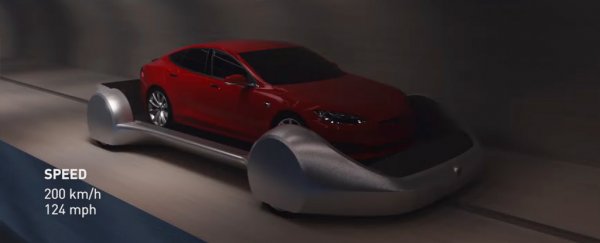Elon Musk isn't a man who likes to be kept waiting. After hinting last year at a new venture to dig roads underground, it seems the super-billionaire visionary won't be satisfied with ordinary old tunnels.
These ones will put your car on a sled and shoot it along at speed of up to 200 km/h (124 mph). Because why the hell not?
In a conversation with TED's head curator, Chris Anderson, Musk explained his tunnel vision for a high-speed future.
"You should be able to get from Westwood to LAX in 5 to 6 minutes," Musk said; a huge difference to the usual half-hour trip for Los Angeles commuters.
This is a man who loves his tunnels – just as construction begins on a prototype tube for the Hyperloop project in the Nevada desert, images of a large tunnel boring machine nicknamed 'Nannie' have been leaked, decorated with the logo for what Musk has named the Boring Company.
A 10-metre-wide (33-foot) test trench has already been dug on the grounds of SpaceX's headquarters in LA. The boring machine seems to be the next step in testing the feasibility of drilling a whole new network of tunnels beneath the city's traffic-clogged streets.
"If you think of tunnels going 10, 20, 30 layers deep (or more), it is obvious that going 3D down will encompass the needs of any city's transport of arbitrary size," Musk told WIRED magazine in January.
This latest reveal shows Musk has more in mind than just channelling the city's traffic into a rabbit-warren of underground highways.
He'll move the cars around on wheeled platforms that are linked to the road, more or less like an old-fashioned slot-car.
These sleds will be lowered into the tunnel system where they will be accelerated at high speed to your destination, all under the guidance of a central computer system.
If you find it hard to visualise, this animation will give you some idea of how it could possibly look:

Tunnelling under cities might sound like an obvious move to clear away gridlock, but there are good reasons why nobody has tried it before. The world's largest "mole" (called Bertha) was built specifically to dig out the Alaskan Way Viaduct replacement tunnel in Seattle, and it only grinds away at a mere 10 metres (33 feet) a day, while requiring 25 people just to operate the thing.
Add to that the time and costs of mapping the geology, negotiating with city planners – not to mention keeping the interests of those above ground in mind – and the whole idea starts to sound a little ludicrous.
Still, we've come a long way since Isambard Kingdom Brunel dug his "insane" tunnel under the Thames in the 19th century, figuring the last thing the river needed was another bridge.
And if it's one thing Musk has it's the money to find solutions to impossible goals, although the Boring Company isn't exactly moving much faster than good ol' Bertha anyway.
"This is basically interns and people doing it part time," Musk said.
Their goal right now is just to find some way to make their boring machine move faster than Gary, their pet snail.
"Gary is capable of currently going 14 times faster than a tunnel boring machine. We want to beat Gary. He's not a patient little fellow, that will be victory. Victory will be beating the snail."
It's difficult to know exactly how seriously to take the idea; on one hand, Musk has himself admitted they have no idea what they're doing.
But it's tough not to feel enthusiastic about a super-rich entrepreneur sinking their own cash into a crazy idea that has a slim chance at solving a problem that drives us all incredibly nuts.
